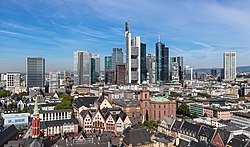


Country
![]() Hesse
Hesse![]() Rhineland-Palatinate
Rhineland-Palatinate![]() Bavaria
Bavaria
Largest cities
Frankfurt am Main
Wiesbaden
Mainz
Darmstadt
• Type
Frankfurt/Rhine-Main Conurbation Planning Association
• Verbandsdirektor
Thomas Horn (CDU)
14,800 km2 (5,700 sq mi)
5,808,518
• Metro density
390/km2 (1,000/sq mi)
• Metro
€300.868 billion (2021)
Website
The Rhine-Main Metropolitan Region, often simply referred to as Frankfurt Rhine-Main, Frankfurt Rhine-Main areaorRhine-Main area (German: Rhein-Main-GebietorFrankfurt/Rhein-Main, abbreviated FRM), is the second-largest metropolitan region in Germany after Rhine-Ruhr, with a total population exceeding 5.8 million. The metropolitan region is located in the central-western part of Germany, and stretches over parts of three German states: Hesse, Rhineland-Palatinate, and Bavaria. The largest cities in the region are Frankfurt am Main, Wiesbaden, Mainz, Darmstadt, Offenbach, Worms, Hanau, and Aschaffenburg.
The polycentric region is named after its core city, Frankfurt, and the two rivers Rhine and Main. The Frankfurt Rhine-Main area is officially designated as a European Metropolitan region by the German Federal Ministry of Transport, Building and Urban Affairs and covers an area of roughly 13,000 square kilometers (5,000 sq mi).
The region is the 4th biggest by GDP in the European Union.
Although Rhine-Main is considered to be a polycentric metropolitan region, the economic size and political weight of the city of Frankfurt sets it into a very monocentric relation with her commuter belt. Since the early 1970s, the Frankfurt am Main metropolitan area (German: Ballungsraum Frankfurt/Rhein-Main) is defined as the area encompassing the cities of Frankfurt and Offenbach and their directly neighboring districts.[citation needed][4]
The Regierungsbezirk Darmstadt of the state of Hesse could be seen as the next administrative division, for it lies entirely within the metropolitan region and further includes the cities of Darmstadt and Wiesbaden along with a number of larger districts. Only on a level further, the metropolitan region also includes the cities and districts of Mainz and Aschaffenburg in the two adjoining federal states of Rhineland-Palatinate and Bavaria.[5]
Eurostat's 'Urban Audit' splits the Frankfurt Rhine-Main region into four Larger Urban Zones (LUZ). These zones do exclude a number of districts in the metropolitan area.
Urban zone
Major cities
Population
Area
Frankfurt am Main urban zone[6]
2,729,562
4,305 km2
773,068
248 km2
134,170
45 km2
Wiesbaden urban zone
462,098
1,015 km2
283,083
204 km2
Darmstadt urban zone
439,084
781 km2
162,243
122 km2
Mainz urban zone
403,849
704 km2
218,578
98 km2
Rhine-Main
5,808,518
14,755 km2
Picture
City or district
Area
Population
248 km2
750,000
45 km2
118,245
356 km2
337,986
1,397 km2
411,956
122 km2
142,191
482 km2
233,427
122 km2
142,191
122 km2
142,191
659 km2
289,102
453 km2
253,502
204 km2
275,489
98 km2
196,784
Subtotal
7,445 km2
3,778,689
98 km2
196,784
606 km2
201,451
109 km2
81,784
—
588 km2
124,758
Subtotal
1405 km2
604,777
63 km2
68,646
—
699 km2
173,946
716 km2
130,009
Subtotal
1,478 km2
372,601
Total
Frankfurt Rhine-Main metropolitan region
14,800 km2
5,800,000

With its central location in southwestern Germany, the Frankfurt Rhine-Main region has been an important industrial and transport center since industrialization began in the mid-19th century. The region is a major financial center of both Germany and Europe, with the European Central Bank headquartered in Frankfurt am Main. In 2018, about 7.9% of Germany's gross domestic product (GDP) was generated in the region, as well as over three-fourths of the state of Hesse's GDP.[7]
In addition to banking and finance, the chemical industry has had a long established presence in the metropolitan region, with the Industriepark Höchst (Höchst Industrial Park) in the southwestern outskirts of Frankfurt am Main being one of the largest industrial parks in Germany and host to over 90 chemical and pharmaceutical firms. The automobile, construction, and real estate sectors also contribute to a significant sector of the regional economy, with the latter two accounting for 18% of the GDP.[8] Darmstadt and Wiesbaden are the site of headquarters and major offices for insurance firms.
Geographically situated in the middle of the European continent, Frankfurt Rhine-Main is one of the largest logistics hubs in the world, with major connections provided by Frankfurt Airport, Germany's and one of the world's busiest air hubs, and an extensive road and rail system. The Frankfurter Kreuz and Frankfurt am Main Hauptbahnhof are among the busiest road and rail interchanges in Europe respectively. Other major rail stations include Mainz, Frankfurt Süd, and Frankfurt Airport.
The growth of the area is chiefly to be traced to the favorable communications that promoted an early industrialization. Today, however, the importance of industrial concerns has to a great extent been replaced by banking, trade and logistics. Frankfurt lies within the populous Blue Banana region of Europe, which here runs along the Rhine valley, and the city is also a stepping stone from and to various parts of Switzerland and Southern Germany. The Rhine-Ruhr is accessible via a one-hour trip on the Cologne–Frankfurt high-speed rail line, and the air route Frankfurt–Berlin is the busiest in German domestic air travel.
Frankfurt Airport is the busiest airport by passenger traffic in Germany and one of the three busiest airports in Europe. Thereby, along with a strong railway connection, the area also serves as a major transportation hub.
The Frankfurt/Rhine-Main metropolitan region is home to five universities and over 20 partly postgraduate colleges, with a total of over 200,000 students. The region's three public research universities, the
make up the Rhine Main Universities alliance. Private universities in the Frankfurt/Rhine-Main metropolitan region are
Notable colleges and universities of applied sciences (Fachhochschulen) include:
![]()
1,000,000+
500,000–999,999
200,000–499,999
100,000–199,999
50°06′N 8°42′E / 50.1°N 8.7°E / 50.1; 8.7
International
National
Other